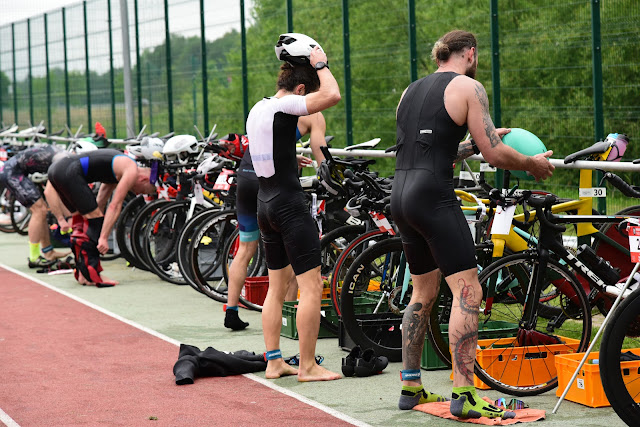Kaišiadorys Triathlon 2025
Just two weeks after completing the Riga Marathon, I jumped straight into another challenge — the Olympic distance triathlon in Kaišiadorys. These two weeks were focused on recovery and targeted prep, and the results definitely showed...
Race morning in Kaišiadorys felt more like early autumn than summer. The air temperature was just 13°C, and the water — a chilly 18.6°C. A thick fog covered the lake...
The transition zone was set up right near the lake, on the tennis courts — compact and organized, making it easy to navigate during the race. I arrived early to set up my gear and pick up my race number.
Each athlete received a bib with a chip, which needed to be strapped to the leg — classic setup for accurate time tracking across all three disciplines. It was a smooth check-in, and everything felt well-managed by the organizers.
Despite the chilly morning, the atmosphere was already buzzing — athletes warming up, last-minute gear checks, wetsuits going on, and everyone mentally locking in for the challenge ahead.
Start of the race...
Swimming had always been my weak point, mostly because my training had always centered around running. So this time, I shifted gears — the main goal was simply to adapt my body to swimming. In the month leading up to the triathlon, I was also recovering from a heavy race schedule: first, the Kaunas Marathon on April 27, then the Riga Marathon just three weeks later on May 18, and finally this triathlon in Kaišiadorys on June 1 — only two weeks after Riga.
Despite the tight turnaround and recovery from both marathons, I managed to complete just 8 focused swim sessions — each one 3 km — totaling 24 km. That consistent but limited effort helped build both my confidence and endurance in the water.
On race day, it paid off. I covered the 1,500-meter swim in 28:27, averaging a pace of 1:54 per 100 meters — my best open water performance so far. The actual distance I swam was probably a bit longer, as I had to veer off the straight line at times to avoid crowded packs of other swimmers. Still, I found my rhythm, stayed focused, and the wetsuit helped conserve energy and keep me warm.
Transition zone after swimming...
One major change this time was my bike setup, and it made a crucial difference. I installed carbon wheels, which added that extra stiffness and responsiveness, especially noticeable on flats and slight inclines. But I didn’t stop there — I also switched to a triathlon-specific saddle for better comfort and positioning, added aero bars for better aerodynamics, and wore an aero helmet to cut through the wind more efficiently. All of that paid off. I averaged 37.09 km/h on the bike leg — a big leap for me — and it helped me gain serious time in the overall standings. The route was mostly smooth and fast, but with wind and cool morning air...
Coming off the bike, my legs felt surprisingly fresh — I settled into a steady pace and managed to run 10 km in 41:11, holding a strong 4:07 min/km pace throughout the run leg. Interestingly, that’s now the same average pace I run in marathons...
What makes this race even more meaningful is the overall improvement I achieved. My total time dropped from 2:29 to 2:24 — a 5-minute personal best — despite the fact that the bike course at the Kaišiadorys Triathlon was 44 km, compared to the standard 40 km in my previous triathlons in Trakai. So not only did I go faster, I did it on a longer, more demanding course...
The Kaišiadorys Triathlon marked the third race in just 33 days — a stretch that tested my limits both mentally and physically. It started with the Kaunas Marathon on April 27, followed by the Riga Marathon on May 18, and culminated in the Olympic distance triathlon on June 1. Each event pushed me in a different way, but together, they painted a clear picture of progress...
In this triathlon, my swim improved significantly thanks to focused training; my bike speed jumped after upgrading to carbon wheels, an aero helmet, a triathlon saddle, and aero bars; and my run leg held steady at marathon pace (4:07 min/km). Three races, three cities, and one consistent goal: to become faster, smarter, and — most importantly — more resilient. This stretch has been a true milestone in my endurance journey — and I’m only getting started…






















Comments
Post a Comment